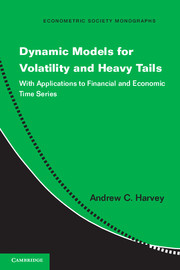 Dynamic Models for Volatility and Heavy Tails
Dynamic Models for Volatility and Heavy Tails Book contents
- Frontmatter
- Contents
- Preface
- Acronyms and Abbreviations
- 1 Introduction
- 2 Statistical Distributions and Asymptotic Theory
- 3 Location
- 4 Scale
- 5 Location/Scale Models for Non-negative Variables
- 6 Dynamic Kernel Density Estimation and Time-Varying Quantiles
- 7 Multivariate Models, Correlation and Association
- 8 Conclusions and Further Directions
- A Derivation of Formulae in the Information Matrix
- B Autocorrelation Functions
- C GED Information Matrix
- D The Order of GARCH Models
- E Computer Programs
- Bibliography
- Author Index
- Subject Index
- Other titles in the series
3 - Location
Published online by Cambridge University Press: 05 May 2013
- Frontmatter
- Contents
- Preface
- Acronyms and Abbreviations
- 1 Introduction
- 2 Statistical Distributions and Asymptotic Theory
- 3 Location
- 4 Scale
- 5 Location/Scale Models for Non-negative Variables
- 6 Dynamic Kernel Density Estimation and Time-Varying Quantiles
- 7 Multivariate Models, Correlation and Association
- 8 Conclusions and Further Directions
- A Derivation of Formulae in the Information Matrix
- B Autocorrelation Functions
- C GED Information Matrix
- D The Order of GARCH Models
- E Computer Programs
- Bibliography
- Author Index
- Subject Index
- Other titles in the series
Summary
Linear Gaussian unobserved components models, such as the random walk plus noise of (1.1), play a central role in time series modelling. The Kalman filter and associated smoother provide the basis for a comprehensive statistical treatment. The filtered and smoothed estimators of the signal minimize the MSE of the estimation error, the likelihood is given as a byproduct of one-step prediction errors produced by the Kalman filter and the full multistep predictive distribution has a known Gaussian distribution.
We now want to confront a situation in which the location is buried in noise which is non-Gaussian and which may throw up observations that, when judged by the Gaussian yardstick, are outliers. The aim is to develop an observation-driven model that is tractable and retains some of the desirable features of the linear Gaussian model. Letting the dynamics be driven by the conditional score leads to a model which not only is easy to implement, but also facilitates the development of a comprehensive and relatively straightforward theory for the asymptotic distribution of the ML estimator.
Modelling the additive noise with a Student's t distribution is effective and theoretically straightforward. Indeed, the attractions of using the t distribution to guard against outliers in static models are well-documented; see, for example, Lange, Little and Taylor (1989). The general error distribution is less satisfactory for reasons discussed at the end of the chapter. However, it does point to some interesting connections with dynamic quantiles.
- Type
- Chapter
- Information
- Dynamic Models for Volatility and Heavy TailsWith Applications to Financial and Economic Time Series, pp. 59 - 96Publisher: Cambridge University PressPrint publication year: 2013
